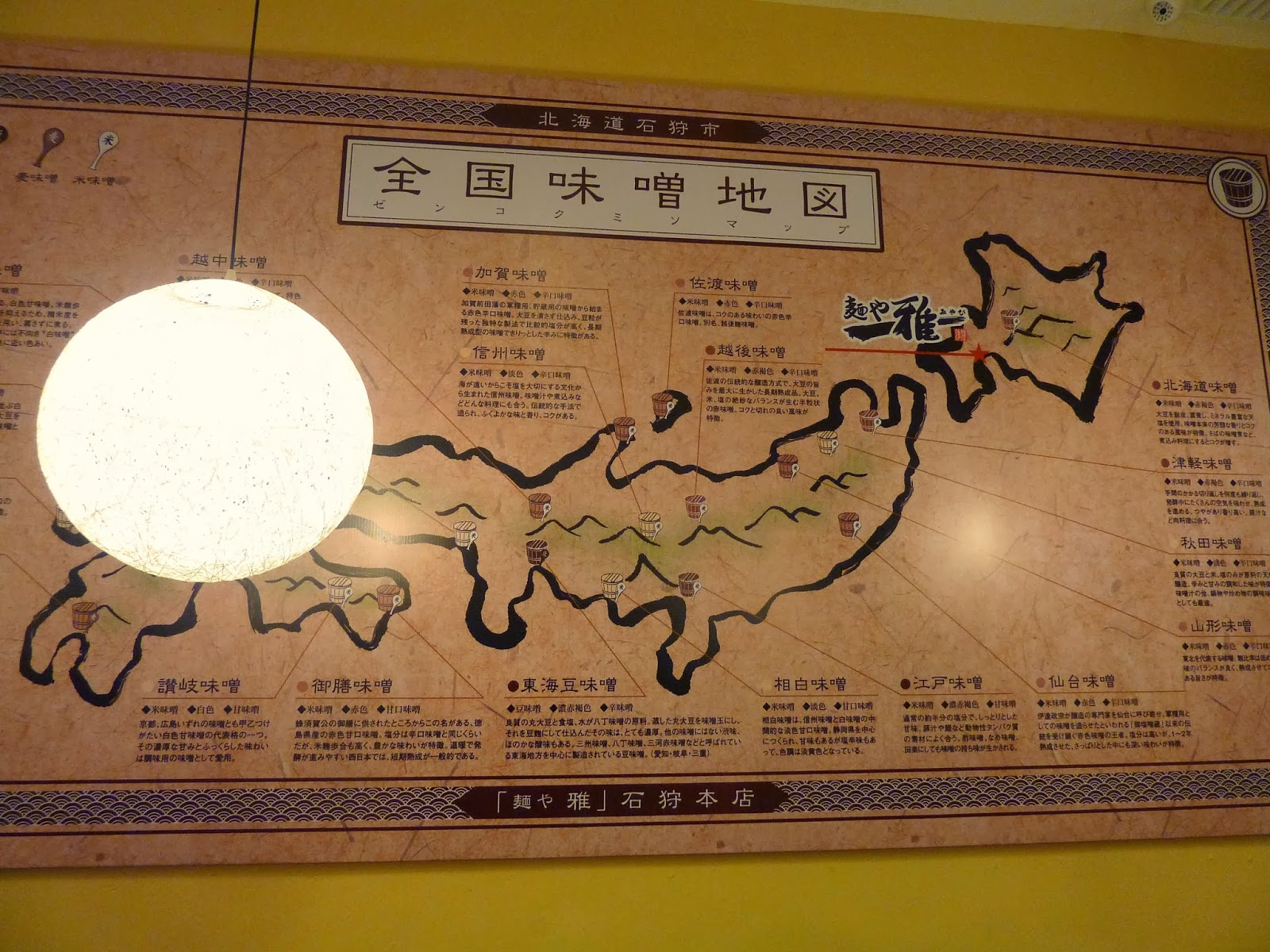Menya Miyabi specializes in Hokkaido-style ramen noodles, which is characterized by the highly flavorful miso broth. Miso paste (味噌) is derived from the fermentation of ground soybeans (or grains in general) with salt. The color of fermented mass ranges from nearly white to reddish-brown to dark brown, depending on the type of grain and degree of fermentation.
In Hokkaido, the most common way to prepare broth for ramen is by boiling miso with meat stock such as pork bones (豚骨, tonkotsu). Another variation originating in Hakodate (函館), a coastal city in Hokkaido, uses salt to create a clearer type of broth. As for the city of Asahikawa (旭川), the broth here is typically flavored by soy sauce instead.
Besides ramen, Menya Miyabi also offers a handful of chow mein (焼き麺) and rice dishes (ご飯もの). However my self-imposed rule is to always go for the signature dish during my first visit to any restaurant.
The dining area is quite small compared to the number of customers during peak hours. This explains the row of chairs outside the store for the comfort of waiting customers. Menya Miyabi opens at 11:00am but the place is usually filled up by noon.
An interesting map shows the many types of miso in Japan. Generally, each type is characterized by the type of grain used for fermentation, color and taste. Popular choices of grain are soybeans (大豆), barley (大麦) and rice (米). The signature miso in the Hokkaido Prefecture is made from rice, has a reddish-brown hue, and yields a strong, pungent flavor.
A brief lesson on geography: The Japanese archipelago consists of four main islands, starting from the northeast are Hokkaido (北海道), Honshu (本州), Shikoku (四国) and Kyushu (九州). As the northern-most Hokkaido experiences harsh winters, the miso produced here tends to be stronger in taste. Pungency a common characteristic of cuisines from colder regions, such as Korea (고추장, gochujang) and Manchuria (豆酱, doujiang).
By the way, the furigana for 地図 was written as "mappu" (マップ). I thought the kanji for 地図 should be pronounced as "chizu" (ちず).
As always, I went straight to Menya Miyabi's signature dish, the Yaki-Miso Ramen (焼き味噌ラーメン, RM23.00). For an extra RM3.50, the bowl of ramen is made large. My advice is to go for large if you have the stomach capacity because what you are about to enjoy is so gratifying that you will regret that you did not order a large portion. In addition, I opted for the add-on of Corn & Butter (コーとンバター, RM3.50) which turns out to be a sound choice.
The food presentation is visually appealing. A generous amount of ramen noodles is served in thick, brown miso broth (味噌汁). Two slices of Char Siew (チャーシュー) and a one-half Marinated Soft Boiled Egg (味付たまご) give material substance to the noodles. At a corner, a heap of sweetcorn and a creamy block of butter constitute the Corn & Butter add-on. The dish is made complete with several pieces of Flavored Bamboo (メンマ), a slice of Nori (のり) and a spoonful of scallions (ワケギ).
The ramen noodles are thicker than regular types and have a starchy and chewy texture. I think it is a right choice as the broth is strong in taste. Thicker noodles serve well to absorb the rich flavor of the broth without being overwhelmed completely.
No mortal words can completely epitomize the rich flavor of miso broth. Savoriness in food is often derived from amino acids, which explains why food taste better when cooked (cooking breaks down complex proteins to simpler amino acids). In this case, the amino acids are produced by bacterial breakdown of protein-rich soybeans. Coupled with the ideal amount of salt, the broth is very appetizing and satisfying to say the least.
The Char Siew slices are a delightful treat to my enjoyment of the ramen noodles. Thin cuts of pork have nice meaty flavor on their own, but the melding with miso broth brings the taste to another level. Certainly a must-have key ingredient in this dish.
This is the first time I encounter Flavored Bamboo in ramen soup dishes, yet I am pleasantly surprised with how it well it goes with miso broth. The moderately-thin slices of bamboo shoot are enriched with the saltiness from the broth. However, the bamboo shoots will eventually turn soft, therefore it is best to consume them when they are still crunchy. The same can be said for the Nori (seaweed).
The addition of butter is a heavenly enhancement to the ramen dish. At first, I was skeptical with the compatibility of butter and miso broth, partly because dairy products are almost never used as ingredients in traditional East Asian cuisine. As it turns out, once the butter has melted, it gives a creamy consistency and fulfilling milky flavor to the broth.
As for the sweetcorn, this add-on has a sweet twist when eaten with ramen. The corn grains are crunchy and juicy especially before they become soggy from being submerged in the broth for too long.
There is an add-on of Mochi (もち) or Japanese rice cake which I did not try because I feel that my meal is heavy enough already.
I am not sure whether it is polite to finish the miso broth to the last drop, but I did it anyway. Who cares when I am really enjoyable my food? Anyway, a large wooden ladle/spoon is provided to facilitate this feat.
Some of the condiments provided at each dining table are Shoyu (醤油) or soy sauce, Chili Oil (ラー油), Chili Pepper (一味唐辛子), Black Pepper (黒コショウ) and Vinegar (酢). I personally recommend adding several sprinkles of Chili Pepper and one or two drops of Chili Oil if you want to spice things up. I know for a fact that some purists insist that it is poor Japanese dining etiquette to use condiments after a meal is served, because implies that the chef did not prepare a nice meal. But I usually ignore this criticism because I want to get a feel of different angles of flavor with my food.
According to the restaurant, the miso broth is faithful to the authentic Hokkaido flavor, but this may be too strong or salty for some diners. Should customers prefer milder taste, the kitchen crew is more than happy to provide extra soup to make the broth more dilute. Nevertheless, I chose not to do so because when in Rome, do as the Romans do.
The waiting service at Menya Miyabi is professional and attentive, although I highly recommend that the servers to be more well-versed in knowledge of food and ingredients that they serve. Like many lively Japanese restaurants, welcoming greetings of "Irrashaimase!" (いらっしゃいませ, "Welcome!") and "Arigatogozaimasu" (ありがとうございます, "Thank you!") can be heard as continuous flow of customers patronize the restaurant.
















No comments:
Post a Comment